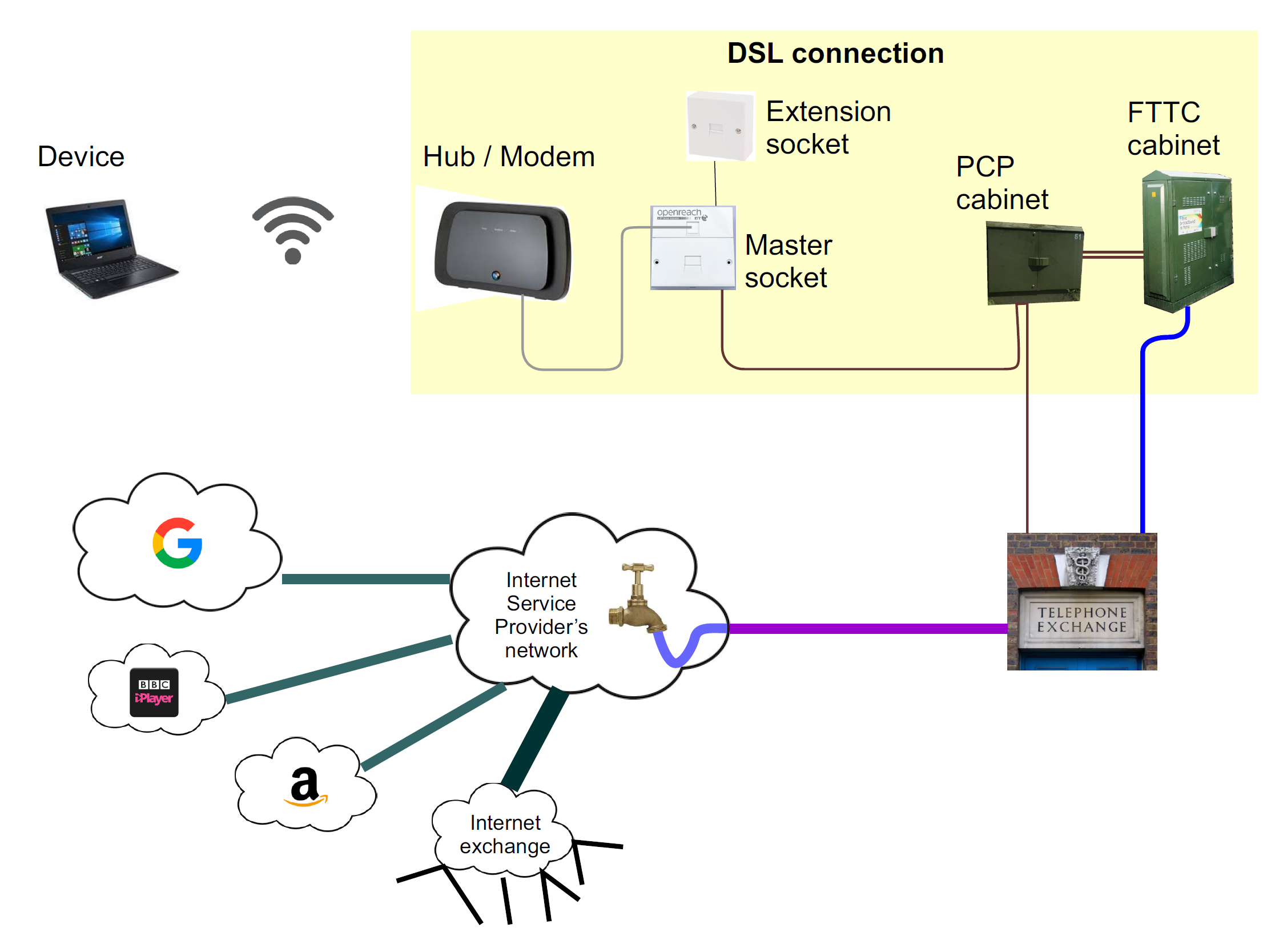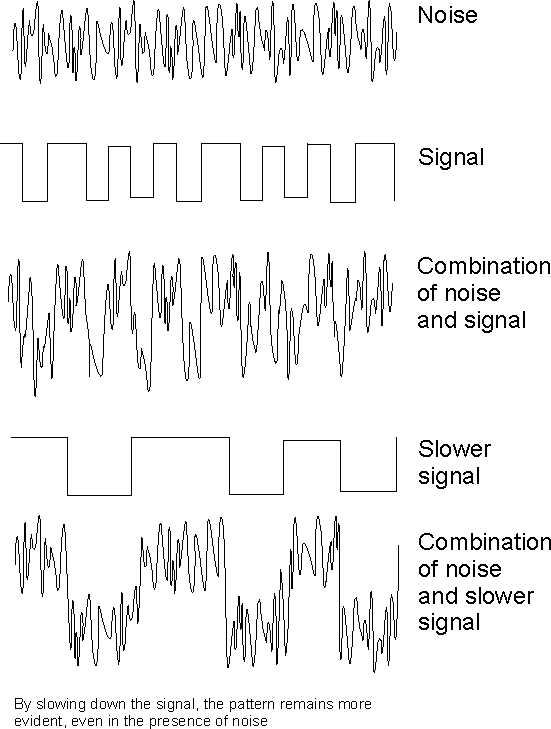As my friends know that I work with technology, often the conversation finds it's way to the topic of:
"Why is our internet going slow?"
To answer this I've put together this explanation of the various different places that it might be slowing down:

WiFi:
Let's start with the connection between your device and the hub/modem. In most cases laptops/phones use WiFi to connect to the network. WiFi is usually reasonably robust within a room, but gradually slows down the further away in the house you get. It might also suffer from interference, including from things such as baby monitors, some electric toys, strip lights - or indeed other WiFi networks.
To rule out your WiFi being the cause of the problem, if possible connect a computer to the hub with wired connection, and try a speed test using www.speedtest.net if the speed is better on a wired connection, then the wireless is likely to be the cause of the problem.
Hubs/modems sometimes benefit from being restarted (many will auto select a WiFi frequency when first switched on, so restarting may cause it to choose a new one free from interference). Don't restart them too often though, as this can sometimes cause other problems.
A note about 2.4G vs 5G: You'll sometimes see WiFi referred to a 2.4G or 5G .... simplistically 2.4G is older and used by most devices, and tends therefore to suffer from interference. 5G is newer, and less exposed to interference, but doesn't travel through walls/ceilings as well. WiFi also comes in many different speeds (E.g. 802.11g provides speeds up to 54mpbs, compared with 802.11n which can do several 100mbps)
In a large house you might really need more than one wireless access point.
Hub/Modem:
Nowadays these tend to be an 'all in one' device, combining a 'Wifi access point', a 'router' and a 'modem' - but sometimes you may have two (or even three) separate devices. The hub usually also acts as a "DNS server" - acting as a directory to look-up domain names into IP addresses.
Not all hubs/modems are equal unfortunately - and some struggle to provide the speed that the internet connection is capable of - particularly if there are a large number of devices connected, or heavy usage such as gaming.
It's often hard to tell if the hub/modem is slowing things down - but if a speed test gives a good result, but the internet still feels 'sluggish' - this can be a sign that the hub/modem is struggling. Why?: A speed test is actually pretty simple for a hub to do - download one big file for a few seconds from one place - whereas normal use might involve lots of domain name look-ups and creating lots of TCP-IP sessions to many different servers.
As a very crude rule of thumb, if your hub came free from your internet service provider, and is more than a couple of years old, it's a reasonable bet it might be slowing things down at times of heavy use.
DSL connection:
Now we get into how the internet connection is delivered to your home.
For the purpose of this blog, I'm not covering Virgin Media 'cable broadband' - just focusing instead on the products provided by BT Openreach (and often resold by others).
The underlying technology used is known a DSL - this gets marketed as three main products to consumers:
- Good old broadband - 'up to 8mbps' - technically known as ADSL Max
- "Broadband" - 'up to 24mbps' - technically known as ADSL2+
- "Fibre broadband" - sometimes referred to a FTTC, or VDSL
All three work in broadly the same way - a modem at your house connects to a DSLAM elsewhere. For ADSL Max and ADSL2+ the DSLAM will be the local telephone exchange, for FTTC/VDSL it will be in a street-side cabinet (necessary, as VDSL only delivers high speeds over short distances).
All three are affected by the length and quality of the line between the router and the DSLAM.
You can check which services are available on your line, and the likely speeds possible by putting your phone number into this Openreach tool: http://dslchecker.bt.com/
It shouldn't matter whether you use Talktalk, BT, Sky, Plusnet, or whoever to provide your internet service - all of them (except Virgin Media) will usually be buying the same line off BT Openreach, and therefore the line will be capable of the same speed.
There are a few subtle differences to this, particularly around Talktalk in 'unbundled' exchanges - but that's beyond the scope of this blog.
It is however important to note that different ISPs might buy a different product to be delivered by the line - for example ADSL Max is available with upload speeds of 384kbps (normal domestic product) or 768kbps (typically only sold to business customers), or FTTC/VDSL is typically available in an 'up to 40mbps' version and 'up to 80mbps' version.
Most internet service providers have systems which allow their technical staff to see the actual line-speed currently synchronised on your line, and compare this to BT Openreach's expected speed. They should therefore be able to tell you if there is a problem with the DSL connection. Similarly some modems allow you to see the current line-speed too.
Slower than expected DSL speeds can be caused by a range of factors:
- A damaged phone line - you'll have to persuade your phone provider to get this investigated/fixed - but problems can include damaged cables, or water getting into cable joints.
- Poor quality wiring within the house, such as phone extension sockets. Some broadband installations using a new face-plate on the Openreach master-socket to filter out the rest of the phone wiring in the house, but if you are using plug-in filters and have extension sockets (even if you are not using them) - they might be slowing things down. Often it is worth getting a new DSL filtered face-plate.
The modem and DSLAM will normally try to synchronise at a speed which achieves a signal-to-noise ratio of 3dB - this is achieved by using slower speeds on noisier lines. If the line suffers repeated drop outs, the DSLAM may force a higher signal to noise ratio, potentially all the way up to 18dB - which may improve stability, but at the expense of slowing down the connection. The signal to noise adaption can work in a variety of different ways - some more persistent than others. Newer DSLAMS/modems also use additional technologies to better handle intermittent noise on the line, without permanently slowing down the connection. Generally once a stable connection has been achieved, the connection remains in place until either the modem is restarted, or the connection is dropped.
In some cases a new modem can improve the speed, as new modems may include newer features that better handle poor quality lines and noise.
In general there is more electrical noise around during the hours of darkness - so a modem that synchronises at night will typically synchronise at a slightly slower speed, than the same one synchronising during the day.
This diagram attempts to illustrate why a slower connection works better on a noisier line:

Backhaul congestion
Once past the DSL connection, the next part of the connection is from the FTTC cabinet/DSLAM to your internet service provider's network. Some internet service providers have their own 'point of presence' in hundreds of local exchanges, so this connection might be very short - others rely upon BT to provide backhaul to their network, and will choose how much backhaul capacity to buy from BT (sometimes unfortunately, they don't buy enough).
If you hear people talking about 'contention ratios' - this was a concept BT used on their old network - e.g. 20:1 contention ratio meant that twenty 8mbps end user connections, shared 8mbps of core network capacity. This is no longer relevant on Openreach's 21st Century Network (21CN).
Internet Service Provider Network
Finally the connection reaches the Internet Service Provider's (ISP) core network. This provides connectivity to their other customers, to other ISP networks (and hence to their customers), and in larger ISP's this may have dedicated connectivity to services such as iPlayer. Some of these connections will be shared across many different services - and congestion could occur on any individual one of these links. For example, iPlayer might be working fine, but a network connection to another website could be overloaded.
The ISP network might also apply a technique known as 'traffic management' or 'throttling'. Put simply, this is where the ISP deliberately constrains the amount of bandwidth available to some customers, to act as a way of sharing out capacity across the network. Typically this is only applied to heavy users once they have exceeded a threshold, and may only be applied at certain busy times of the day.
This is another of the areas where 'you get what you pay for.' Some providers that focus on providing cheap internet connections are cheap because they have fewer or smaller of the expensive connections to other ISP networks, and might therefore rely more upon throttling to keep their network running.
Congestion within the ISP's network often manifests itself as a slower down at particular times of the day when internet use is busy. If the ISP is the cause of the slow down, the only really solution is to change provider.
The website or service that you are accessing
The final piece of the jigsaw is the website, or service, that you are actually trying to access. It will be hosted somewhere with its own connection to the internet. The website or its connection might be overloaded, or might simply not have a very high speed connection.
People sometimes find that accessing their company IT systems can be slow - it may sometimes be the case that the company internet connection itself is something like an ADSL2 connection (24mbps download, 1 mbps upload) - in which case when you are 'downloading' at home, the link at the office is constrained by the 1mbps upload at the office.
Other slowing factors
Something/someone using all your bandwidth
Of course one possibility is that there is nothing wrong with your connection at all, but that something or someone is using a lot of your bandwidth.
This could be something routine like a computer or phone downloading software updates, or something malicious like a virus doing something less desirable.
It could even be that your neighbour's kids have hacked into your WiFi to work around the controls their parents put on theirs!
A good starting point is to temporarily change your WiFi password, and connect just one device and check whether the speed has improved.
Software slowing down your computer
Less common nowadays, but still sometimes the cause of a problem can be software running on a computer itself - virus scanning software might be checking every web page visited, and in doing so it could be slowing things down. It's unlikely to be a problem with a modern computer - but if your computer's 10 years old, it probably wasn't designed for browsing the internet at today's speeds.
Bits and Bytes:
Finally, are you looking for a problem that doesn't exist? - check you haven't got your bits and bytes in a muddle.
A byte consists of 8 bits of data.
Internet connections are generally sold as speeds measured in bits - e.g. 'up to 24mbps'
Computers however, tend to reports speeds in bytes - e.g. '3MB/sec'
So if you've got a 'up to 24mbps' connection - then you are never going to see faster than 3MB/sec, because 3MB/sec is 24mbps.
It's a common mistake.
